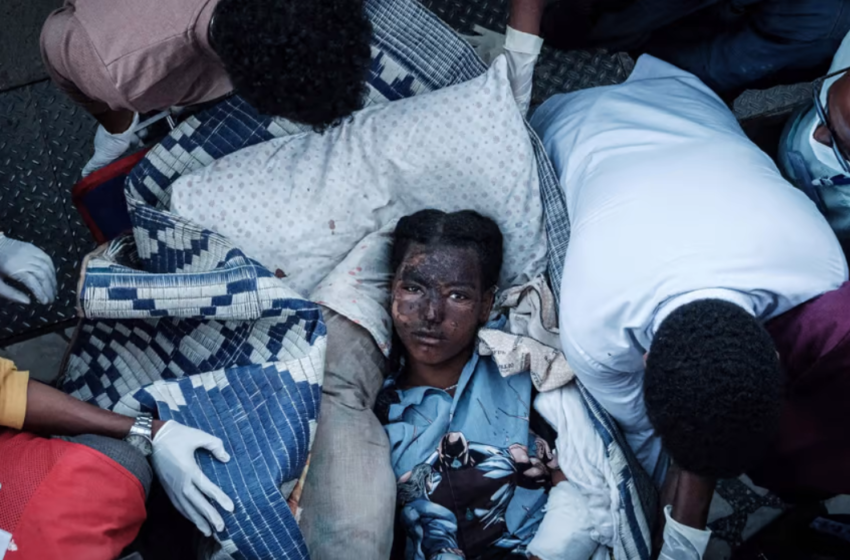
There’s Genocide in Tigray, but Nobody’s Talking About it
The reasons range from Internet shutdowns to just pure racism.
Source: The Nation
A humanitarian crisis is taking place in northern Ethiopia, but you may not have read about it in the news. In fact, you may have never heard of the Tigray National Regional State, which is currently encircled by Ethiopian and Eritrean forces. Those troops are setting up blockades, burning food silos, and going from village to village committing genocidal massacres and rapes.
If we compare the situation in Tigray to other ongoing armed conflicts, the numbers are startling. Looking at civilian deaths, for example, the war in Ukraine has resulted in less than 3,000 Ukrainian deaths, according to the UN Human Rights Office, while Tigray has seen upward of 500,000, as per estimates by Ghent University.
Ethiopian politics are complex. The nation has five parliamentary parties, 17 other national parties, and 15 other regional parties. In March 2020, Ethiopian Prime Minister Abiy Ahmed postponed the general elections set for August to 2021, citing the Covid-19 pandemic. The local Tigrayan government called this an unconstitutional attempt to extend his mandate and held local elections anyway. Abiy cut funding to the region and the Tigray People’s Liberation Front responded by attacking federal command headquarters in the Tigrayan capital of Mekelle, after which Ethiopian and Eritrean forces began their siege.
But the violence is not merely political—it’s also racial. There is long-standing conflict among Ethiopia’s three main ethnic groups—Oromos, Amharas and Tigrayans—as well as a desire among Eritreans to settle an old score with Tigray after decades of border conflict. The resulting ethnic tensions have led to violence that isn’t limited to Tigray. Tigrayans across the country face attacks.
Ahlam “Lala” Mohammed, a 21-year-old university student from Washington, D.C., told me that one of her family members was murdered in the capital of Addis Ababa in early April. “He was a Tigrayan and, of course, as a Tigrayan during this time, you are a target. So all you can do is hide your identity or you will be killed.”
To be fair, some outlets, such as Al Jazeera, have provided ample coverage. But it is not enough, and it is dwarfed by the coverage of Ukraine or the Bosnian genocide before it. “I don’t know if the world really gives equal attention to Black and white lives,” WHO director-general Tedros Adhanom Ghebreyesus, himself an ethnic Tigrayan based in Geneva, said at a press conference given on April 13. “I need to be blunt and honest that the world is not treating the human race the same way. Some are more equal than others.”
“This is one of the longest and worst sieges of modern history,” Tedros told me recently. “There are 7 million people sealed off from the outside world for 18 months now. I haven’t spoken to my relatives in Tigray in 18 months, because telecoms are cut off. They are starving. But I can’t send money because banks are closed.”
War in Europe is startling to Western audiences, and it carries with it echoes of World War II and Nazi Germany, the horrors of the Holocaust, and the words “never again.” Tigray, meanwhile, is a foreign and unfamiliar land where discerning who the bad guys are can be difficult. Too often for US and European readers, the reaction to conflict in Africa or the Middle East is for many to shrug and say, “Isn’t that region always at war anyway?”
Of course, another reason for the media’s heavier focus on Ukraine is its geostrategic importance not only for Europe, but also, some would argue, Western liberal democracy. In Tigray, there is no threat of nuclear conflict or global economic repercussions, whereas Ukraine supplies 12 percent of the world’s wheat and 17 percent of its corn.
Finally, the Ethiopian government cut Internet access in Tigray on November 4, right before the fighting broke out, further contributing to our lack of knowledge about what’s happening there. Tigray is far from the only region that has been cut off from the rest of the world in this way. According to a 2021 report by the digital civil rights group, Access Now, authorities cut Internet access at least 182 times in 34 countries last year, including in 12 African countries. As in China, Russia, North Korea and elsewhere, controlling Internet access is a means of throttling democracy. But Tigray is in one of the worst situations in the world. The longest ongoing shutdown, in the Federally Administered Tribal Areas (FATA) of Pakistan, lasted five and a half years, followed by less than two years in Myanmar’s Rakhine state, and one and a half years in Tigray. However, as Tedros noted, Tigray contains over 7 million people, while there are just 5 million in FATA and 3 million in Rakhine.
Even just talking to refugees presents a challenge, since Google Translate, for example, doesn’t feature Tigrinya, the official language of the region. Asmelash Teka, the Tigrayan creator of Lesan (“language”), an online translation service for Tigrinya, told me in English: “It’s been super difficult to share Tigrayan stories, because few people speak the language, but most importantly, Tigray has been sealed off, so the news that comes out of Tigray is from media outlets in Addis that are mouthpieces of the ruling party. It takes months until big media companies pick up news of massacres or rape and give them attention, if any at all.”
In addition, even dissident Tigrayans who live outside Ethiopia and speak foreign languages fluently are reluctant to speak up for fear of retaliation. Meaza Gebremedhin, a Tigrayan activist who lives in D.C., told me she not only has a hard time getting anyone’s attention but also avoids Ethiopian restaurants because of the potential danger from being recognized. “I’ve been targeted both online and in real life,” she said. “In addition to the ever-increasing cyberbullying, a gun was pulled on me in LA last year while I was leading a peaceful protest, by a self-proclaimed defender of the Ethiopian government.”
These intimidation tactics make it harder for Tigrayans to tell the world about the atrocities occurring in their homeland, such as the massacre of up to 800 civilians in the town of Aksum, on November 28 and 29, 2020. The massacre barely made headlines in the West but has forever changed the lives of people like Guesh Lisanework, an engineer living in Addis Ababa. “There are so many friends; surrounding people who grew up with us, killed the same day as my family,” Guesh said. Guesh’s father, Leake Lisanework, and brother, Binyam Lisanework, were barley farmers in Aksum. “My father is the one who advocated for me my entire life,” Guesh said. “My father, brother, the husband of my older sister, my aunt’s cousin and two other family members, Teklay Fitsum and Kibrom Fitsum, were killed by Eritrean forces at our home compound.”
After the massacre, survivors from Aksum who knew Guesh’s family visited him in Addis Ababa to tell him the news. Guesh said he became ill. “It has been so hard to adapt to the reality that I lost my father, my brother, the husband of my sister,” said Guesh. “Every event and holiday I remember them, how they gestured, how they treated me.”
What repeatedly comes across from Tigrayans is the fear that their suffering means nothing and the hope, even as they remain cut off from the world, that someone is listening.
Featured image: An injured resident of Togoga, a village about 20km west of Mekele, arrives on a stretcher to the Ayder referral hospital in Mekele, the capital of Tigray region, Ethiopia, in 2021. (Yasuyoshi Chiba / Getty Images)
